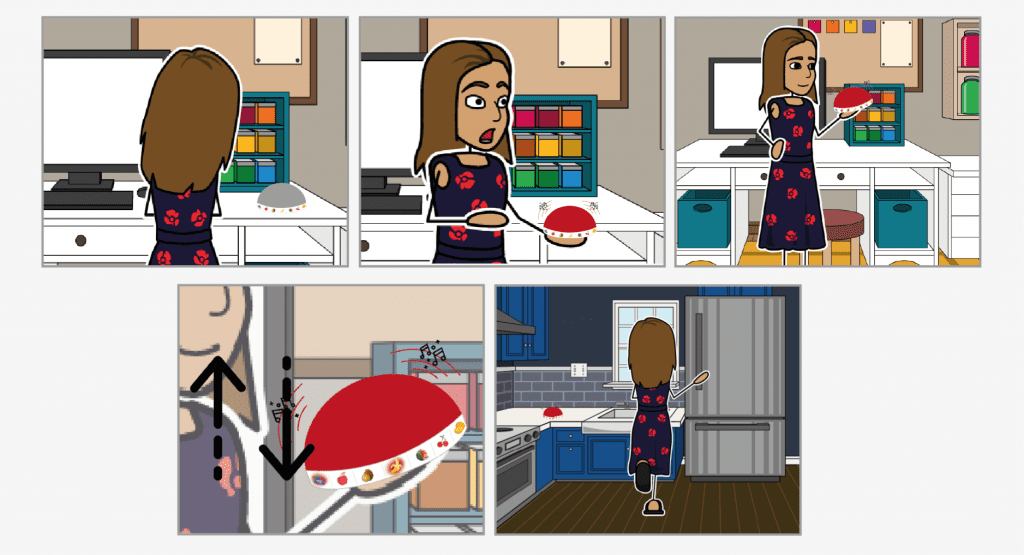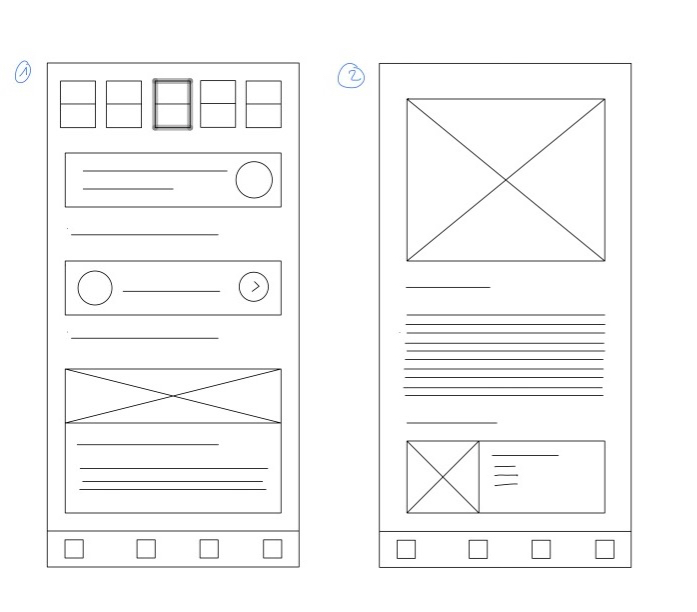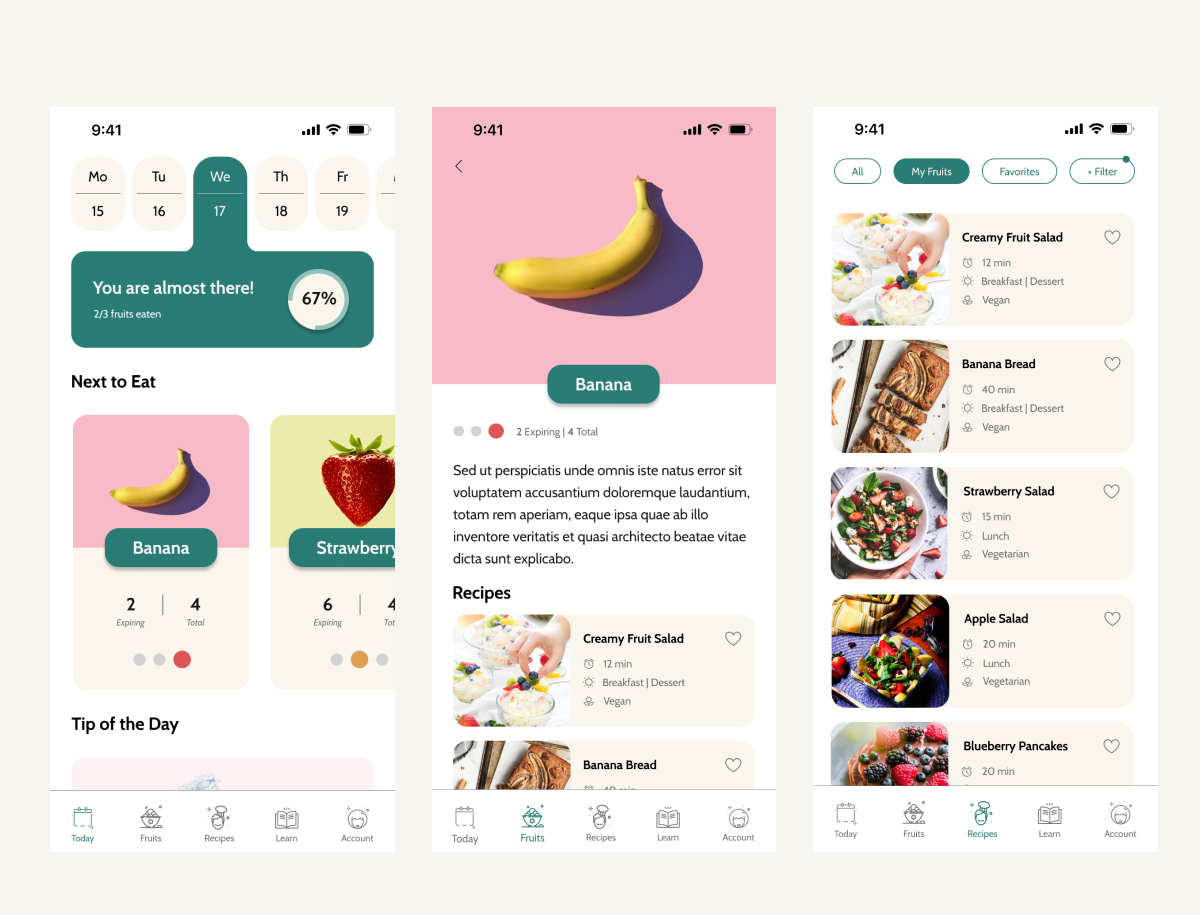Making Fruit Consumption More Sustainable and Fun.
Lemin
As part of a university research project, myself and four teammates conceptualized, prototyped and tested a solution aimed at improving the experience of buying, storing and eating fruit. We conducted initial research and developed the concept for a prototype as a team.
We then each designed the final product individually, staying in close contact to make sure we were still in alignment with our goals and requirements. .
Deliverables
Diary Study
Focus Group
Interviews
Wireframes
Product Design
User Research
Understanding fruit eating habits with a 10-day diary study
Short Shelf Life
Food Waste
Missing Excitement
Based on our research, we identified three major pain points around fruit.
The Fruit BFF
The Fruit Acquaintance
“Help me build more fruit into my diet, in order to be healthier and avoid food waste.”
The Fruit BFF
The Fruit Acquaintance
“Help me build more fruit into my diet, in order to be healthier and avoid food waste.”
We also developed two main personas with different needs, that could both benefit from our solution.
Concept Testing
Developing an initial prototype that alerts users about the state of fruit in their fridge and presenting it to a focus group
For our first concept, we decided to developed an initial prototype for a physical device that would alert users whenever a fruit was about to go bad. The device detects available fruits and ripeness stages automatically through sensors placed in the fridge and fruit storage spaces. To test this prototype, we organized a focus group with 5 participants.
The idea was to hold the focus group in person, showing the prototype to participants and acting out how it would be used in everyday life. Due to the pandemic situation, however, we had to switch to a remote focus group one day before the planned date. To still give participants a good idea of the prototype, we created a storyboard presenting a use case and a sketch of the prototype.


Storyboard presenting the prototype and a possible use case
Main takeaways from the focus group discussion:
The idea was well received and participants understood the functions and value
A recipe function was brought up and seen as extremely useful in combination with the device
Participants agreed that a color coded system would be most helpful to show the fruit ripeness, and the green = ready to eat was most easily understood
Participants wished for a smaller device like a bracelet or simply a mobile application
Addressing Behavioral Barriers to Eating More Fruit
Possible features to address the behavioral barriers to fruit consumption and promote behavior change
To address the pain point of struggling to include fruit into the everyday diet, we brainstormed additional features and solutions for common behavioral barriers, utilizing Steve Wendel’s CREATE action funnel.
Habit Stage
Cue
Barrier
Forgetting to eat fruit, not planning the fruit into everyday meals
App Features
Habit Stage
Reaction
Barrier
No positive association with fruit, preferring other options
App Features
Highlighting immediate benefits, Making fruit eating fun through trackers & games
Habit Stage
Evaluation
Barrier
Preparing fruit seems like too much effort
App Features
Highlighting easy & quick options, like simply eating a banana
Habit Stage
Ability
Barrier
User doesn’t know how to prepare fruit or how to use it in a recipe
App Features
Detailed recipe suggestions & preperation advice for each fruit
Habit Stage
Timing
Barrier
No urgency, procrastinating on eating the fruit
App Features
Creating urgency by showing the optimal ripeness level and when it will likely be over
Habit Stage
Barrier for Behavior
Cue
Forgetting to eat fruit, not planning the fruit into everyday meals
Reaction
No positive association with fruit, preferring other options
Evaluation
Preparing fruit seems like too much effort
Ability
User doesn’t know how to prepare fruit or how to use it in a recipe
Timing
No urgency, procrastinating on eating the fruit
App Features
Highlighting immediate benefits, Making fruit eating fun through trackers & games
Highlighting easy & quick options, like simply eating a banana
Detailed recipe suggestions & preperation advice for each fruit
Creating urgency by showing the optimal ripeness level and when it will likely be over
Possible application features to address each barrier within the action funnel.
Design
Sketching Ideas


Design
Wireframing


Design
UI Design
Using the wireframes, I conducted some initial testing and was able to identify some improvements. I decided to add the amount of total and expiring available fruits on the home screen, as well as the detailed fruit screen. I would also include corresponding tips of the day on the fruit pages.
After implementing the improvement in my wireframes, I then moved on to design the final screens in Figma. My goal was to create a visual identity that was fun and engaging.


Explore More Case Studies:
Lemin | UX Research & Design
I joined Lemin, a startup developing a coaching software for team and personality development, in its initial beta-testing and launch phase. Based on insights discovered during user research, I implemented design changes that resulted in an increased engagement rate of 7%.
APS Germany | Web Design
APS specializes in offering jet blast and run-up noise protection solutions for the airport industry. By giving the website a modern update, and providing strategic opportunities for clients to get in touch, I increased the contact rate by 9%.